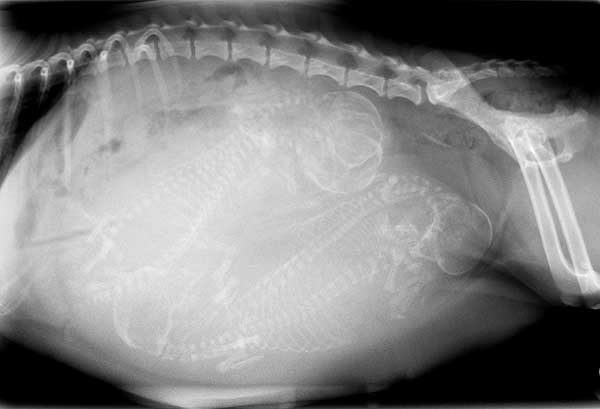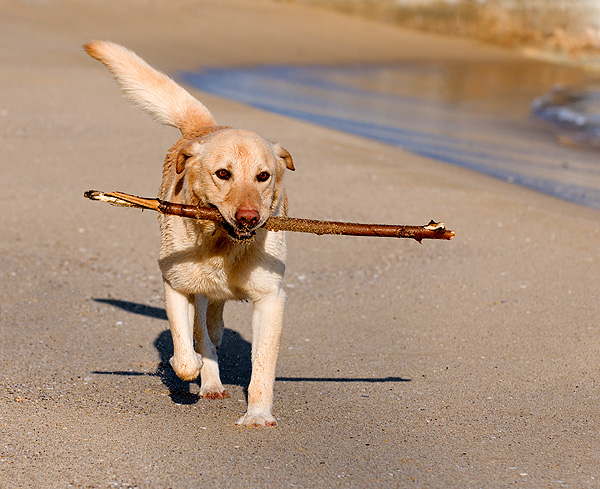If you purchased your dog from a breeder or acquired your dog from a litter with a known birth date, then you know your dog’s age precisely. However, plenty of dogs out there were acquired from shelters or found as strays. The age reported to you by the shelter may be inaccurate — sometimes, it seems, inexperienced volunteers are assigned the task of estimating ages of dogs and puppies when they arrive, which leaves many pet parents wondering, “How old is my puppy, really?” Here’s how to tell a dog’s age — within reason.

This article will go through the stages of canine development and aging so that you will have some idea of how to estimate a dog’s age. But don’t forget that dogs, like humans, age at different rates. Some age well, and others don’t. The difference is based upon genetics and lifestyle. There can be very marked differences in aging between breeds — a Great Dane is elderly at seven years old, whereas a seven-year-old Chihuahua is barely middle aged.
How to estimate a dog’s age
Birth to 2 weeks of age: Newborn puppies are born toothless and with their eyes closed. These features can be used to identify puppies that are less than two weeks of age. Puppies this age spend most of their time rooting, suckling, and sleeping.

2 to 5 weeks old: The eyes open at two to three weeks of age although vision is poor. There will still be no teeth present. Puppies this age become more engaged with their environment and begin to explore their surroundings.
5 to 8 weeks old: This period is marked by the eruption of deciduous (baby) teeth. Yes, that’s right: Dogs, like humans, have two sets of teeth. The first set begins to erupt at five to six weeks of age, and the full set is generally in place by eight weeks. These teeth are very sharp, and people with puppies in this age group will be painfully familiar with them. By the time a puppy is eight weeks old he or she will be in full-on puppy mode with periods of active playing, exploring, chewing mixed with periods of passed-out sleep.
8 to 16 weeks old: The deciduous teeth are in place, but the space between them will increase as the jaw and face grow. They will also begin to appear disproportionately small since they stay the same size while the puppy grows around them. This is a period of intense activity, growth, exploration, and learning for the puppy.
16 weeks to 8 months old: At around 16 weeks the baby teeth begin to fall out and be replaced by permanent teeth. This process starts at the front of the mouth with the small teeth called incisors, and then works its way back, generally in a symmetrical fashion. The puppy’s mouth may bleed slightly (or his or her breath may sometimes smell like blood) as the baby teeth fall out. The deciduous teeth are generally gone by five months, and the permanent teeth generally are fully erupted by eight to 12 months of age.
8 months to 24 months old: Most dogs have reached their full height by eight to 12 months of age (although some giant breeds continue to grow for up to two years). They are adolescents — not quite puppies, but not quite mature dogs. Like adolescents, dogs in this age group go through puberty (if they aren’t neutered or spayed). And like adolescents, they are generally clumsy and awkward and they may have skin problems (puppy mange often strikes around this time, or sometimes a bit earlier).
2 to 3 years old: Most dogs’ physical development is complete by two years of age. Alas, it often is not long after this that time to begin to take its toll. The first sign of aging usually is visible in the mouth: dental calculus and even gingivitis will be present in the majority of dogs by three years of age if their teeth aren’t brushed.
3 to 7 years old: Humans this age would be considered in the prime of their lives. However, some signs of aging will occur during this time. Dogs whose teeth do not receive attention (either through brushing or professional dental work) will generally experience progressive dental disease. Gray hairs may develop on the muzzle. Activity levels will slow.

7 years and beyond: As I mentioned above, different sizes of dogs age at different rates. Seven years is generally the time at which these differences become pronounced. Many larger breeds of dogs will show significant signs of arthritis (manifested by mobility problems), while smaller dogs may not exhibit these issues for another three to five years. At seven years of age most dogs’ eyes will become slightly cloudy. This natural aging phenomenon is a type of cataract, but it does not significantly compromise vision or quality of life. They may develop wart-like growths on their skin (similar to moles in people), or soft growths called lipomas underneath the skin. Their voices may change to a raspier tone. Smaller dogs may begin to show symptoms of collapsing trachea (manifested most frequently by coughing when active). Hearing and vision may fail (although the vision loss is not usually linked to the cloudiness in the eyes). Mobility may progressively deteriorate. Dental disease may become profound and if the mouth is not cared for teeth may fall out.
How to keep your dog young
As mentioned above, genetics (especially breed) plays a significant role in the rate at which dogs age. However, so does lifestyle. Two of the hallmarks of aging are dental disease and mobility concerns. Therefore, one of the simplest ways to slow the aging process is to take care of your dog’s teeth by brushing them at least daily and seeking professional dental care when needed. Another way is to keep your dog active and control his or her weight. Active dogs whose weights are ideal are less likely to experience symptoms of arthritis, collapsing trachea, and the other ravages of aging.
Does the 7-to-1 rule work for determining a dog’s age?
Conventional wisdom holds that one dog year is the equivalent of seven human years. As this article illustrates, that conventional wisdom is not exactly correct. The first two years of a dog’s life are roughly equivalent to 21 years in human. The rate of aging varies significantly thereafter, primarily based upon a dog’s size. A Great Dane may age 10 to 12 “human” years for each subsequent year, whereas a teacup Poodle may age only at a ratio of about 5-to-1.
As your dog ages I recommend that you not lose track of an important notion. Getting old may not be fun, but it generally beats the alternative.
Read more about senior dogs:
- Addressing Pain in Senior Dogs
- 7 Reasons Senior Dogs Make Great Adoptions
- How Can We Help Senior Dogs as They Age? A Geriatrics Primer
- What Behavioral Changes Can I Expect from an Older Dog?
- Seven Major Health Concerns for Senior Dogs
- How to Calculate a Dog’s Age in Dog Years
- Owner Uses Water Therapy to Relieve Dog’s Arthritis
- 5 Tips for Caring for Senior Dogs
Thumbnail: Dalmatian by Shutterstock
The post Ask a Vet: How to Tell a Dog’s Age appeared first on Dogster.
No comments:
Post a Comment